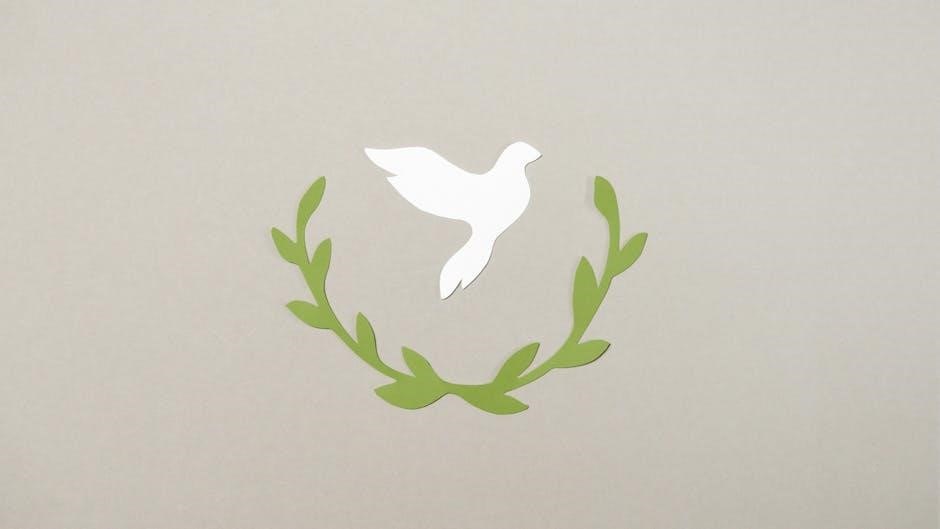PDF Origami combines traditional origami techniques with digital tools, enabling precise, shareable designs․ It enhances creativity, ensures accuracy, and makes patterns accessible globally for enthusiasts and artists alike․
1;1 Definition and Concept
PDF Origami refers to the digital creation and manipulation of origami designs using Portable Document Format (PDF) files․ It combines traditional origami principles with modern digital tools, allowing for precise folding patterns, scalable designs, and easy sharing․ This concept leverages PDF’s universal compatibility to ensure designs remain intact across devices and software․ It bridges the gap between physical craftsmanship and digital innovation, offering a versatile medium for artists, educators, and enthusiasts to explore and innovate in origami․
1․2 Historical Background
Origami, an ancient Japanese art, has evolved with digital advancements․ The concept of PDF Origami emerged in the early 1990s with the rise of PDF technology by Adobe․ This format allowed precise, shareable designs, revolutionizing how origami patterns were distributed․ The integration of digital tools in the 2000s further enhanced its accessibility, enabling creators to craft intricate designs digitally․ This blend of tradition and modernity has fostered a global community, making origami more accessible and collaborative than ever before․
1․3 Importance of PDF in Modern Origami
PDF technology has revolutionized origami by enabling precise, shareable, and accessible designs․ It allows artists to create and distribute intricate patterns globally, fostering collaboration and innovation․ The format ensures consistency and clarity, making it ideal for educational resources and professional projects․ PDFs also support version control, enabling iterative improvements and archival of designs․ This digital evolution has democratized origami, bridging traditional techniques with modern tools and inspiring a new generation of creators worldwide․

Tools and Software for PDF Origami
PDF origami relies on specialized tools like Adobe Acrobat, Origami Studio, and Foldify․ These programs offer design, editing, and simulation features, catering to both beginners and professionals․
2․1 Overview of Popular PDF Editors
Popular PDF editors like Adobe Acrobat, Foxit PhantomPDF, and Nitro Pro are essential for origami design․ These tools allow users to create, edit, and enhance PDF patterns with precision․ Features like layer management, annotation, and shape manipulation are crucial for intricate designs․ They support the creation of step-by-step guides, ensuring clarity for folding․ These editors are versatile, catering to both beginners and advanced artists, making them indispensable for modern origami workflows․ Their ability to handle complex layouts ensures high-quality, printable designs for various projects․
2․2 Specialized Software for Origami Design
Specialized software like Origami Studio and FoldSim are tailored for origami design, offering unique features such as 3D simulations and fold visualization․ These tools enable precise pattern creation and step-by-step instructions, enhancing both traditional and digital origami workflows․ They cater to all skill levels, from beginners to advanced artists, ensuring intricate designs are accessible and sharable․ Such software plays a crucial role in modern origami, blending creativity with technical precision to bring designs to life effectively․
2․3 Free vs․ Paid Tools: Pros and Cons
Free tools for PDF origami offer basic features, making them accessible to beginners, while paid tools provide advanced functionality and support․ Free options often lack premium features like 3D simulations or complex design capabilities, but they are ideal for simple projects․ Paid tools, while more expensive, deliver higher precision and customization, catering to professionals․ The choice depends on the user’s needs, budget, and desired outcomes, balancing cost and functionality effectively for both casual and advanced origami enthusiasts․

Materials and Supplies
Premium paper, such as kami or washi, is ideal for PDF origami due to its strength and fold retention․ Digital templates and tools enhance the folding process․
3․1 Types of Paper for PDF Origami
For PDF origami, the choice of paper is crucial․ Traditional options include kami (thin, durable) and washi (strong, textured)․ Chiyogami offers vibrant patterns, while foil-backed paper adds a metallic finish․ Heavier papers like cardstock are ideal for intricate designs․ When printing PDF templates, laser-compatible paper ensures crisp folds․ Eco-friendly options, such as recycled or bamboo paper, are also gaining popularity․ Each type enhances the folding experience, catering to both artistic and functional needs in digital origami projects․
3․2 Essential Tools for Folding
Essential tools for PDF origami include a bone folder or similar blunt tool for sharp creases and a flat ruler for aligning edges․ A cutting mat or protective surface prevents damage during cutting․ Digital tools like PDF editors and design software are crucial for creating and modifying patterns․ Optional items include scissors or a craft knife for trimming paper and tweezers for precision folds․ These tools enhance accuracy and efficiency, making the folding process smoother and more enjoyable for both beginners and experienced creators․
3․3 Digital Resources for Patterns
Digital resources for PDF origami patterns are abundant online, offering a wide variety of designs․ Websites like Etsy and Pinterest provide downloadable templates, while forums and social media groups share user-created designs․ Specialized platforms cater to both beginners and advanced folder enthusiasts, offering customizable patterns․ Additionally, software like Adobe Illustrator and Origami Studio allow users to create and edit their own designs; These resources make it easy to explore diverse origami styles and techniques, ensuring endless creative possibilities for crafters worldwide․

Techniques and Methods
PDF origami combines traditional folding techniques with digital precision․ Tools like Adobe Illustrator enable intricate designs, while methods blend manual craftsmanship with digital accuracy for stunning creations․
4․1 Basic Folding Techniques
Basic folding techniques in PDF origami include mountain, valley, and squash folds․ These foundational methods are enhanced by digital tools, allowing precise alignment and symmetry․ PDFs provide clear step-by-step guides, making intricate designs accessible․ Virtual fold simulations ensure accuracy, while traditional principles remain core to the craft․ This blend of analog and digital approaches simplifies learning, enabling creators to master complex patterns efficiently․
4․2 Advanced Digital Folding Methods
Advanced digital folding methods in PDF origami utilize specialized software for intricate designs․ Tools like 3D modeling and simulation enable precise crease planning and virtual fold testing․ Layering and symmetry features in programs such as Adobe Illustrator or dedicated origami software streamline complex patterns․ These methods allow for the creation of tessellations, modular designs, and highly detailed sculptures․ Digital previews ensure accuracy before physical folding, while AI-driven tools suggest optimal folding sequences․ This fusion of technology and artistry pushes the boundaries of traditional origami, enabling innovative and visually stunning creations with unparalleled precision․

4․3 Combining Traditional and Digital Approaches
Combining traditional and digital approaches in PDF origami bridges the gap between physical folding and digital design․ Digital tools enable precise pattern creation, while traditional techniques refine the physical execution․ This hybrid method allows for scalability, as digital designs can be shared and adapted globally․ Artists often use software to plan and visualize folds before translating them to paper, ensuring accuracy and symmetry․ This blend of methods fosters innovation, making origami more accessible and versatile for both enthusiasts and professionals, while preserving the art form’s traditional essence․

Applications of PDF Origami
PDF origami finds applications in education, art, and commerce, offering scalable designs for creative projects and industrial uses, while preserving the traditional art form’s essence digitally․
5;1 Educational Uses
PDF origami is a valuable educational tool, offering interactive and visual learning experiences․ Educators use PDFs to create step-by-step guides for teaching origami in classrooms, enhancing creativity and problem-solving skills․ The digital format allows for easy sharing and accessibility, making it ideal for remote learning․ Students can explore mathematical concepts like geometry and symmetry through origami designs․ Additionally, PDF origami can be integrated into art and design curricula, fostering innovation and collaboration․ Its versatility makes it a practical resource for engaging learners of all ages and skill levels in educational settings․
5․2 Artistic and Creative Projects
PDF origami serves as a versatile medium for artistic expression, enabling creators to design intricate patterns and share them globally․ Artists use PDFs to craft detailed, layered designs, experimenting with colors, textures, and shapes․ This format allows for precise replication of complex folds, making it ideal for exhibitions and installations․ Additionally, PDF origami fosters collaboration, as designers can easily distribute and modify patterns․ It also bridges traditional craftsmanship with digital innovation, inspiring new forms of artistic exploration and creativity․ This medium has become a cornerstone in modern art, blending tradition with contemporary tools․
5․3 Commercial and Industrial Applications
PDF origami has found practical uses in commercial and industrial sectors, particularly in packaging design, prototyping, and marketing materials․ Companies leverage PDFs to create customizable folding templates for product packaging, ensuring precision and consistency․ This method also aids in cost-effective prototyping for manufacturing․ Additionally, PDF origami is used in healthcare for creating educational models and in retail for designing promotional materials․ Its scalability and ease of distribution make it a valuable tool for industries seeking innovative, efficient solutions․ This application highlights the versatility of PDF origami beyond traditional art forms․

Case Studies and Examples
PDF origami’s impact is evident through real-world examples, showcasing its versatility in art, education, and industry, with projects demonstrating its practical and creative applications globally․
6․1 Successful PDF Origami Projects
Notable PDF origami projects include intricate 3D models like modular cubes and tessellations․ These designs highlight precision and artistry, proving the medium’s versatility in both technical and creative spheres․
6․2 Real-World Implementations

PDF origami is widely used in education, art, and industry․ Educators share folding instructions via PDFs for classroom activities, while artists distribute designs for exhibitions․ Industries leverage PDFs for precise product prototyping and packaging designs, ensuring accuracy and scalability․ This versatility highlights its practical applications across diverse fields, making it a valuable tool for both creative and functional purposes․
6․3 Innovations in the Field
Recent advancements in PDF origami include interactive designs and AI-generated patterns, enhancing creativity and precision․ Tools now offer 3D modeling within PDFs, allowing artists to visualize folds better․ Augmented reality integration helps users follow instructions more intuitively․ These innovations are revolutionizing how origami is taught, designed, and shared, making it more accessible and engaging for both beginners and experts․ Such developments are pushing the boundaries of this traditional art form into the digital age, fostering a vibrant and evolving community of creators․

Challenges and Limitations
PDF origami faces challenges like scaling issues, alignment errors, and software compatibility problems․ Complex designs can be difficult to translate from digital to physical formats accurately and consistently․
7․1 Common Issues in PDF Origami
Common issues in PDF origami include scaling problems, alignment errors, and software compatibility․ Users often face difficulties with precise folding due to mismatched paper sizes or incomplete digital instructions․ Additionally, complex designs may result in inaccurate creases when translated from digital to physical formats․ Printing resolution and file formatting can also lead to discrepancies, requiring manual adjustments․ These challenges highlight the need for precise calibration and high-quality PDF templates to ensure successful origami outcomes․
7․2 Overcoming Technical Difficulties
Overcoming technical difficulties in PDF origami often requires a combination of software proficiency and creative problem-solving․ Ensuring compatibility between PDF editors and design tools is crucial․ Calibrating printers to match digital templates and adjusting scaling settings can resolve misaligned prints․ Additionally, using high-quality PDF templates minimizes errors during folding․ Engaging with online communities or forums for troubleshooting tips and sharing solutions can also enhance the origami-making process․ By addressing these challenges methodically, users can achieve more precise and visually appealing results in their PDF origami projects․
7․3 Future Improvements and Solutions
Future advancements in PDF origami may include enhanced software integration for seamless 3D modeling and AI-driven design suggestions․ Improved tools for real-time collaboration could revolutionize shared origami projects․ Additionally, augmented reality (AR) could provide interactive folding guides, making complex designs more accessible․ Developers are also exploring eco-friendly materials for printing PDF templates, promoting sustainability․ These innovations aim to simplify the process, reduce errors, and expand creative possibilities, ensuring PDF origami remains a dynamic and evolving art form for years to come․

PDF origami bridges traditional art with digital innovation, offering limitless creative possibilities․ Its accessibility and precision make it a valuable tool for artists, educators, and enthusiasts worldwide․
8․1 Summary of Key Points
PDF origami merges traditional folding techniques with digital design, offering precise, shareable patterns․ It enhances creativity, ensures accuracy, and provides global accessibility for artists and educators․ Tools like specialized software and high-quality materials are essential, while applications span education, art, and industry․ Despite challenges like technical limitations, PDF origami’s versatility and innovation drive its growth․ By combining tradition with modern technology, it inspires new possibilities, making it a valuable and evolving art form for future generations to explore and refine further․
8․2 The Future of PDF Origami
The future of PDF origami lies in advancing digital tools and blending traditional techniques with cutting-edge technology․ AI-driven design software could revolutionize pattern creation, while virtual reality might enable immersive folding experiences․ Collaborative platforms may emerge, allowing global artists to co-create designs․ Enhanced accessibility features could make PDF origami more inclusive․ As technology evolves, PDF origami will likely become a standard tool in education, art, and industry, inspiring innovation and creativity on a broader scale while preserving the timeless charm of this ancient craft․
